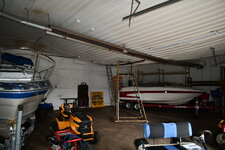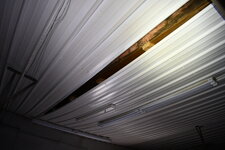PSUengineer1
Structural
- Jun 6, 2012
- 147
Thank you for reading. I have an R-panel metal ceiling (3-foot wide sheets). The ceiling attaches to 2x4 wood nailers (laid flat). Nailers spaced every 30 inches and nailed to truss bottom chords with 2 to 3 10d nails. Trusses are at 6-foot centers. This is in a large storage faciltiy. No collateral evidence of wind damage to building (no metal roof panels displaced, etc.). No water damage. No wood rot. No heavily rusted nails. About 6.5 inches of batt insulation is on top of the metal ceiling. I would think the 24 Gage metal ceiling can hold the weight of insulation. Wondering if nails just backed out because they were nailed in direct withdrawl (not toenailed) and expansition and contraction of wood (hygrometric environmental changes). I don't think wind could cause such a failure. looking for input on attached photos. Thank you in advance!
Attachments
Last edited:


